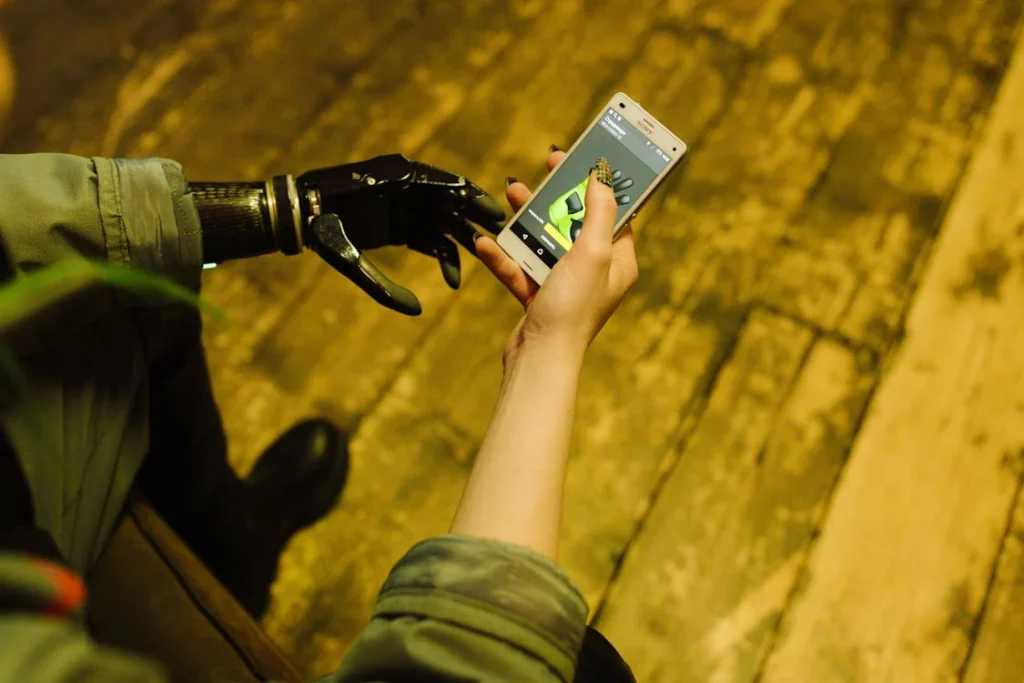When someone loses a limb, one of the first questions they face is: “When should I get a prosthetic—and which kind?” The answer isn’t always simple. At Robobionics, we’ve helped thousands of people through this journey, and what we’ve learned is clear—timing makes all the difference. Whether you start with a temporary prosthetic or wait for a custom one, when you get it matters just as much as what you get.
In this article, we’ll unpack the real-world differences between custom and temporary prosthetics. But more importantly, we’ll dive deep into why acting at the right time—neither too early nor too late—can shape recovery, comfort, confidence, and even long-term health.
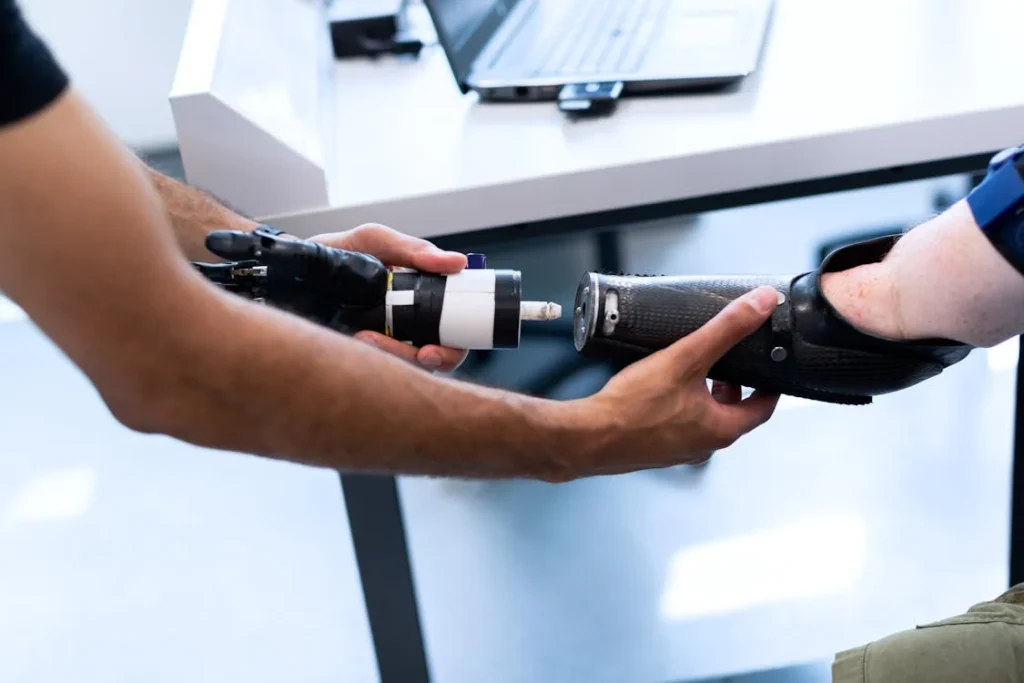
Understanding the Basics: What Are Temporary and Custom Prosthetics?
What is a Temporary Prosthetic?
A temporary prosthetic is a basic limb replacement given soon after amputation. Think of it like a trial run. It’s not meant to last forever—it’s designed to help you start walking or using your limb again while your body is still healing and changing.
After an amputation, your limb (or what doctors call the residual limb) often changes in shape and size over several months. During this time, using a final custom prosthesis would not be ideal. That’s where a temporary prosthesis comes in.
Temporary prosthetics are usually simpler, lighter, and adjustable. They’re quicker to fit and often cheaper. Most importantly, they allow early mobility. When a person starts moving and doing daily activities with a prosthetic early on, it helps their brain, muscles, and body adjust to the idea of using a new limb.
However, these temporary options are not made to last. The fit might get looser as your limb shrinks, or you might find certain movements harder over time. And since they’re made to be temporary, they don’t always include features like advanced grip control or cosmetic finishing.
What is a Custom Prosthetic?
A custom prosthetic is built just for you—made to match your body, your lifestyle, your goals. These prosthetics are carefully fitted once your residual limb has healed and stabilized in size. They can include advanced features like EMG-controlled grips, multi-articulating fingers, and even cosmetic coverings that look like real skin.
The fitting process is more detailed. Prosthetists take exact measurements and often use digital tools to model how your limb moves. You’ll go through a few fittings to get everything just right—from how the socket feels to how your prosthetic helps you balance or grip.
Custom prosthetics offer a better fit, more durability, and advanced control. They’re ideal for long-term use, especially for people who need higher performance—like athletes, professionals, or those who use their hands or legs intensively.
But here’s the thing: custom doesn’t always mean “better right now.” In fact, getting a custom limb too early, before your residual limb has settled, can lead to poor fit, discomfort, and frustration. That’s why timing matters.
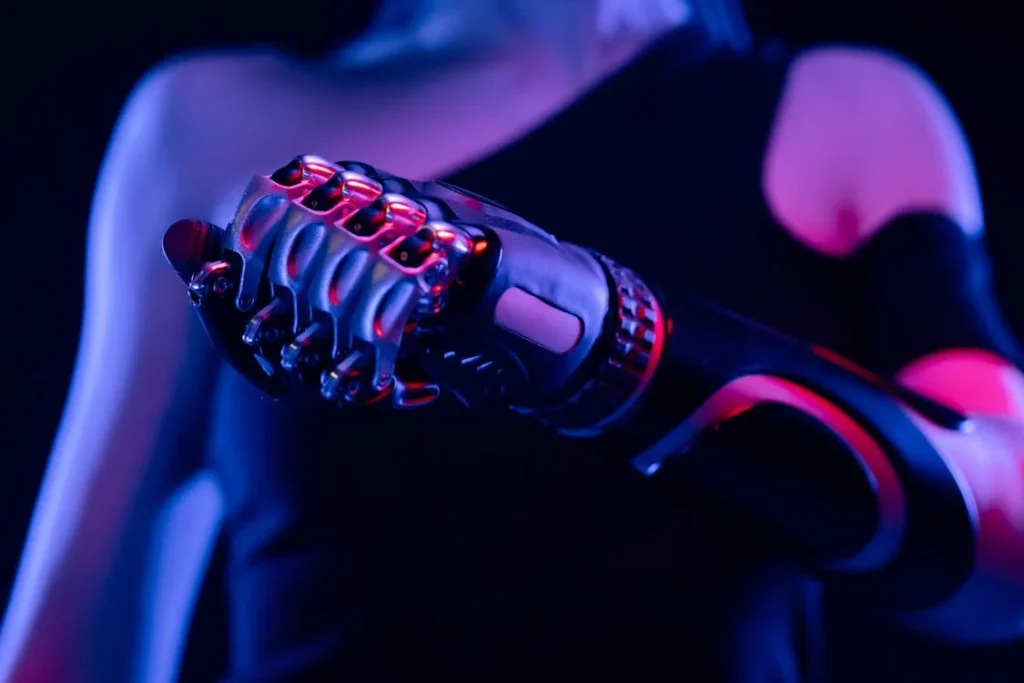
Why Timing Can Make or Break Your Prosthetic Journey
Your Residual Limb Is Still Changing
After surgery, your body goes through a lot of changes. The residual limb (or stump) is swollen at first. Over time, it shrinks. This process is called limb maturation. It’s natural—and it’s one of the most important reasons why you shouldn’t jump into a custom prosthesis right away.
If you get a custom limb too early, what fits today may not fit in two months. And if a prosthetic doesn’t fit right, it can cause pain, wounds, or make you walk awkwardly. Worse, it may discourage you from using it at all. That’s why temporary prosthetics play a key role during this transition. They offer flexibility while your limb finds its stable shape.
The Sooner You Start Using a Prosthetic, the Better Your Brain Adapts
There’s something else happening during this healing period—something in your brain. Scientists call it “neuroplasticity,” which simply means your brain is adjusting to the new reality of having one less limb. The longer you wait to use a prosthetic, the harder it is for your brain to make this adjustment.
Early use of a temporary prosthesis helps your brain rewire itself faster. You start building new movement patterns, balance, and habits. The prosthetic becomes part of you—not a foreign object.
In contrast, people who wait too long often struggle with body image issues, delayed healing, poor mobility, or even depression. A prosthetic isn’t just a device—it’s a bridge between where you are now and where you want to go. And building that bridge early makes the journey smoother.
Muscles and Joints Need Early Engagement
Muscle atrophy is another issue. When you stop using certain muscles, they shrink and weaken. This can start happening just weeks after an amputation. If you don’t start moving and engaging those muscles soon, they lose strength. And weak muscles don’t support a prosthetic well.
With a temporary prosthetic, you can start walking or moving much earlier. This helps preserve muscle strength and joint flexibility. By the time you’re ready for a custom prosthesis, your body is more prepared to handle it.
On the other hand, if you wait for months without any prosthetic use, your body gets used to not having the limb. This leads to poor posture, uneven walking, back pain, and even knee or hip problems. In many cases, a well-timed temporary limb prevents these issues before they start.
Confidence and Independence Start Early
There’s a psychological side to this, too. Imagine going from being fully mobile to suddenly relying on a wheelchair or crutches. The emotional impact can be overwhelming. Temporary prosthetics help break that feeling of helplessness. They allow people to do small things again—stand, walk a bit, pick something up.
These early wins build confidence. And that confidence feeds motivation. People who use temporary limbs often feel more in control of their recovery. They’re less likely to fall into depression or anxiety. By the time they’re ready for a custom device, they’ve already built a rhythm of daily activity and independence.
Waiting too long without any prosthetic support can make the transition harder. It creates emotional resistance. People begin to see prosthetics as scary or complicated. That fear slows down progress.
Timing Affects Long-Term Success
At Robobionics, we’ve seen this over and over. Two patients with similar injuries can have very different outcomes—just because one started with a temporary prosthetic early on, and the other waited. The one who started early typically walks better, has fewer socket issues, uses their custom limb more often, and leads a more active life.
That’s why we don’t just look at the device. We look at the timeline. We help people start with temporary solutions early—so that when the time comes for a custom prosthesis, they’re ready in every way.
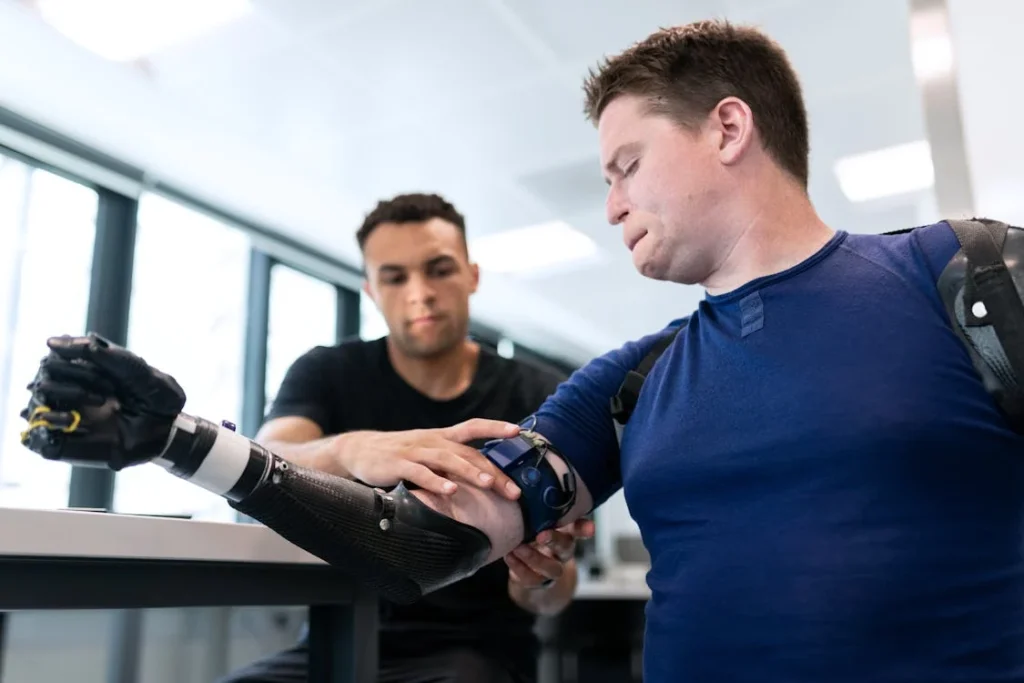
Real-World Differences Between Temporary and Custom Prosthetics
What You Feel vs. What You Think You’ll Feel
Many people expect that getting a prosthetic—especially a custom one—will be like getting a perfect replacement. But the reality is a bit different. The first thing people often notice with a temporary prosthetic is how unfamiliar it feels.
It might feel slightly bulky or awkward. That’s completely normal. The point of a temporary device isn’t to feel natural from day one—it’s to get your body used to walking or using your arm again. It’s part of the learning curve.
Custom prosthetics, on the other hand, can feel like a major upgrade. The fit is snugger, the materials more refined, and the movement more natural. But that’s only if your body is ready.
If you rush into a custom limb before your residual limb stabilizes, it might feel just as awkward as a temporary one—or worse, cause blisters and discomfort. People are often surprised when they find their expensive, custom prosthetic doesn’t work as smoothly as they expected. That’s not because the device is flawed. It’s because the timing was off.
That’s why many rehabilitation specialists recommend a “step-by-step” approach. Start early with a temporary device to allow your body and brain to adapt. Then, when the time is right, you transition into a custom limb that fits your needs precisely.
Adjustments Are Inevitable—and Timing Decides How Many
Another big difference between the two types of prosthetics is how often they need to be adjusted. Temporary prosthetics are designed with adjustability in mind. As your residual limb shrinks, your prosthetist can make small tweaks to improve comfort and fit. The goal is flexibility. It doesn’t need to be perfect—it just needs to keep up with your healing body.
Now contrast that with a custom prosthetic. It’s built to fit a specific limb shape and size. Once your body changes, even slightly, the socket can start to feel too loose or tight. Fixing that usually means expensive adjustments or even having to remake the socket entirely. And if that happens within the first few months of use, it can feel like a waste—not just of money, but of hope.
We’ve worked with patients who were eager to jump straight into a custom limb, only to return weeks later because it stopped fitting well. That’s not a failure—it’s a natural part of recovery. But it’s why starting with a temporary option is often smarter. It saves you time, money, and frustration in the long run.
Daily Life Looks Different with Each Type of Prosthetic
Let’s talk about daily life—because that’s where the real test happens. A temporary prosthetic usually supports basic movement. For a leg prosthetic, that might mean walking in short bursts or practicing balance. For an arm, it might mean holding lightweight objects or doing simple tasks like brushing your teeth or opening a door.
A custom prosthetic, though, can unlock much more. Advanced grip patterns, better suspension, improved joint control—all these make everyday activities smoother.
You can walk longer distances, cook meals, drive, even play sports. But again, these benefits only come when your body is ready. A premature custom prosthetic might perform worse than a well-fitted temporary one. And that’s something most people don’t expect.
What we often see is this: people using a temporary prosthesis start small. They gradually rebuild strength, balance, and coordination. Then, when they get their custom device, they’re already confident and skilled. They can take full advantage of all the features. They don’t have to learn everything from scratch—they’re just stepping up to a more capable tool.
Waiting too long without any prosthetic at all, though, creates a different picture. People lose momentum. Daily tasks become harder. Habits form that don’t support long-term mobility—like sitting for too long or avoiding stairs. By the time they get a custom device, their bodies and minds have to work much harder to adjust.
The Emotional Difference: From Surviving to Thriving
Let’s not forget the emotional side of things. Losing a limb is a traumatic experience, and how a person bounces back often depends on their sense of progress. Temporary prosthetics offer quick wins. Standing up again. Taking a few steps. Picking up a cup. These might seem small, but to someone recovering from surgery, they’re milestones.
We’ve seen patients beam with pride the first time they walk across a room using their temporary limb. That feeling builds confidence, which fuels motivation. They start thinking, “I can do this.” And that mindset is powerful.
In contrast, people who wait months for a custom device often stay stuck in survival mode. They rely on others, feel limited, and may even withdraw from social activities. By the time they get a custom prosthetic, they’re more nervous than excited. It feels like too much, too late. That emotional gap is hard to bridge.
That’s why we always emphasize this: don’t wait for perfect. Start with what works now. A temporary prosthesis might not be sleek or high-tech, but it gets you moving. And movement is healing—not just for the body, but for the spirit.
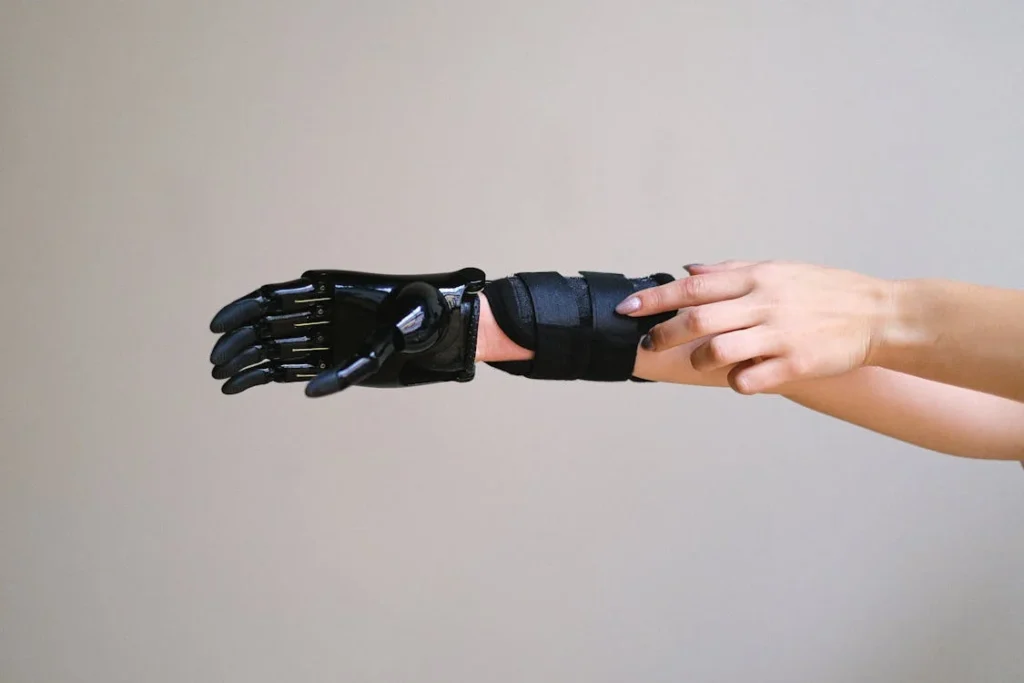
Timing, Cost, and Recovery: Why It’s Not Just About the Device
Why the Right Time Saves More Than Just Money
When people think about prosthetics, one of the first things that comes to mind is cost. Understandably so. Prosthetic limbs—especially custom ones—can be expensive. But what many don’t realise is that the cost isn’t just about the device. It’s also about what happens when you use the device too early or too late.
If someone rushes into a custom prosthesis before their residual limb has fully healed and stabilised, there’s a high chance the socket won’t fit well after a few weeks. When that happens, you need adjustments. And adjustments on a custom device aren’t cheap. Sometimes, the socket has to be replaced entirely. That adds more cost and time to the process.
Now think of the flip side. What if someone waits too long? They skip the temporary prosthetic, hoping to avoid the “extra” expense. At first, it might seem like they’re saving money. But this delay often leads to muscle weakening, joint stiffness, balance problems, and emotional distress. They might need more physiotherapy, more doctor visits, and sometimes even surgery to correct issues caused by inactivity.
In the end, the real cost isn’t the price tag on the prosthetic. It’s the ripple effect of how that decision influences health, independence, and rehabilitation. Investing in a temporary limb early on might look like an extra step, but it’s often what protects people from bigger, long-term costs.
Rehabilitation Success Starts With Momentum
Rehabilitation after an amputation isn’t just about healing wounds—it’s about rebuilding a lifestyle. That process requires momentum. Early wins. Small steps that build into bigger ones. A well-timed temporary prosthesis gives people those early wins.
Let’s say someone receives a temporary leg prosthesis within 4 to 6 weeks after surgery. That person can begin walking short distances, working with a physical therapist, and learning to balance again. Their muscles stay active. Their confidence grows. By the time they get their custom leg—three or four months later—they’re not starting from scratch. They already know how to walk with support. Now, they’re just upgrading the tool.
But if someone waits five or six months without using any prosthetic device, they face a steeper hill. Their body may be weaker. Their balance less stable. Even the basic task of standing might feel intimidating. Recovery slows down, and frustration builds up. They may end up using the prosthetic less—not because it’s bad, but because the gap between surgery and device use was too long.
That’s why timing matters so much. It’s not about rushing. It’s about beginning the right steps at the right time. And temporary prosthetics provide that stepping stone when it’s needed most.
Children, Adults, and Seniors: How Timing Plays Out Differently
Not everyone experiences prosthetic timing the same way. Age, lifestyle, and health all influence what kind of prosthetic you need—and when you need it.
For children, early prosthetic use is vital. Their bodies are still growing, and their brains are still developing movement patterns. The longer they go without a prosthetic limb, the more likely they are to develop habits that are hard to reverse—like leaning on one side or avoiding movement. Temporary limbs help children build a natural rhythm early on, so future custom devices can support healthy development.
For adults, especially working professionals or caregivers, a fast return to daily activities is often the goal. Waiting too long for a prosthetic can interfere with work, parenting, or simply managing a household. Temporary limbs help maintain independence while the body prepares for a custom solution. This ensures they’re not only physically ready, but mentally and socially engaged by the time they receive their permanent device.
For seniors, the challenge is often different. Healing takes longer. Energy levels are lower. And falls can be more dangerous. Starting with a temporary prosthetic, even if it’s used part-time, helps maintain muscle memory and joint function. It also keeps them mobile, reducing the risk of complications like pressure sores, pneumonia, or blood clots from too much sitting or lying down.
In all these groups, timing determines success. Not just in recovery, but in lifestyle and wellbeing. The device is important—but when you start using it is what defines the outcome.
Mental Health and the Role of Purpose
One often overlooked aspect of prosthetic use is how much it affects mental health. Amputation is a life-altering experience. People face grief, fear, and uncertainty. But something powerful happens when they begin to move again—when they regain control, even in a small way.
Using a temporary prosthetic early gives people a sense of purpose. They can do things again. Walk into a room. Get a glass of water. Hug a child without losing balance. These aren’t just tasks—they’re emotional victories. They reconnect people with their identity and self-worth.
We’ve seen it time and again at Robobionics. A patient who smiles for the first time in weeks after standing up with a temporary leg. A teenager who regains confidence at school because they can write with a temporary hand.
A senior who walks in the garden with their grandchild. These moments don’t wait for custom prosthetics. They start with the first step, however small—and that’s where timing becomes everything.
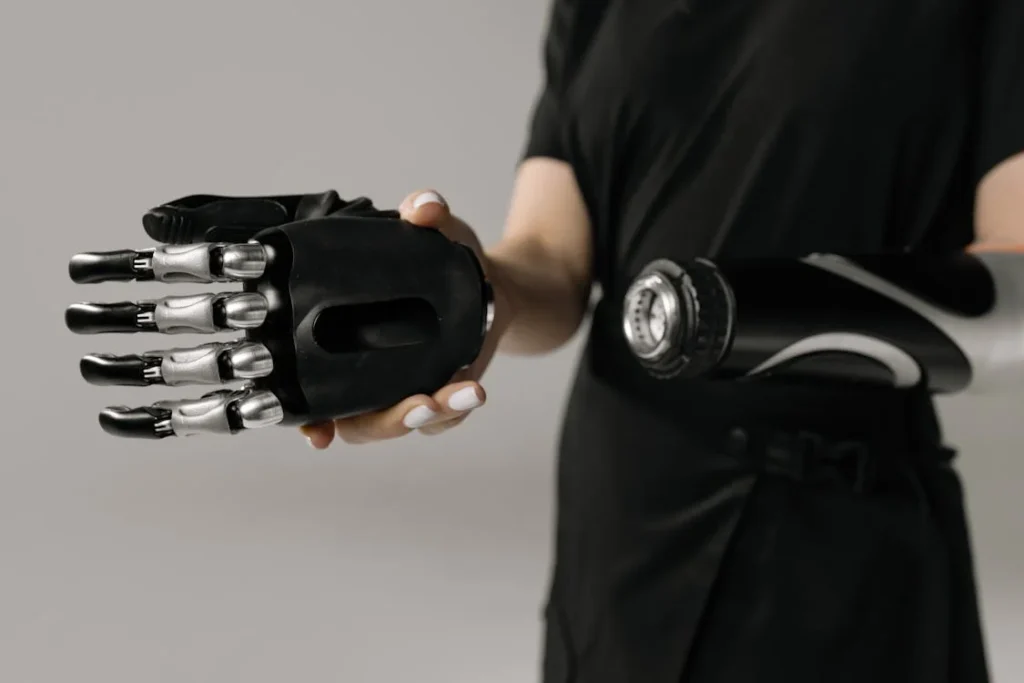
The Hidden Role of Skin, Socket Fit, and Limb Volume: How Timing Affects Your Comfort for Years
Your Skin Isn’t Ready Right After Surgery—and That Changes Everything
When people think about prosthetics, they often imagine the device itself—the foot, the hand, the look, or the tech. But what actually makes or breaks your day-to-day experience with a prosthesis is something far less flashy: your skin.
The residual limb’s skin has just gone through a major trauma. It’s healing from surgery, adjusting to new pressure points, and adapting to new forms of friction. And yet, this is the same skin that must bear the full weight, movement, and pressure of a prosthetic device every day.
If you try to fit a custom prosthetic during this fragile stage, your skin will likely protest. You may develop blisters, pressure sores, irritation, or even infection. Once that starts, the cycle is hard to break. Every day you try to wear the prosthetic, your skin gets angrier. Eventually, people stop using it altogether—not because they don’t want to, but because it hurts too much.
Temporary prosthetics are designed with this challenge in mind. Their sockets are softer, more forgiving, and adjustable. They help train your skin gradually, allowing it to toughen up without getting damaged. It’s like wearing in a new pair of shoes—except much more delicate and important. By the time you move on to a custom device, your skin is more resilient, and your risk of injury drops significantly.
Socket Fit Isn’t Static—It’s a Moving Target
Here’s something we tell every patient: your socket is the most personal part of your prosthetic. It’s where your limb meets the technology. If it doesn’t feel right, nothing else matters. You could have the most advanced prosthesis in the world, but if the socket doesn’t fit, it will end up sitting unused in a drawer.
The tricky part? Your limb changes every day—sometimes every hour. Swelling goes down. Muscles relax or tighten. Fluid levels shift depending on how active you are, what you eat, even how warm the weather is. In the early stages after surgery, these changes are more dramatic. That’s why a socket made today might not fit tomorrow.
Temporary prosthetics account for this fluctuation. They use liners, socks, or adjustable panels that can be tweaked as your limb changes. They give your body time to settle. With consistent use, your limb volume starts to stabilise. That’s when a custom socket begins to make sense—when you can measure the limb and know it will stay mostly the same.
Jumping straight to a custom socket while your limb is still unstable often leads to poor outcomes. The socket might feel perfect for a week and then start causing pain. You’ll end up visiting your prosthetist again and again for fixes that may never fully solve the issue. This is one of the most common sources of frustration—and it’s entirely preventable with good timing.
The Psychological Toll of a Bad Fit
Let’s talk honestly for a moment about what happens when a socket doesn’t fit. At first, people try to tough it out. They adjust their gait, overcompensate with other muscles, or add extra socks and padding.
But that only works for so long. Eventually, they start wearing the prosthetic less. It might begin as skipping one day, then two, then only putting it on when they absolutely have to. The body becomes deconditioned. Confidence fades. Social isolation creeps in.
All this can start from something as small as a 2-millimetre shift in socket fit. That’s how sensitive your residual limb can be.
But if you begin with a temporary device that allows your body to settle naturally, you avoid this spiral altogether. By the time you’re ready for a custom socket, your limb is more predictable. The fit is more precise. The likelihood of long-term use goes up dramatically.
At Robobionics, we’ve even seen patients who were fitted with multiple custom prosthetics from other providers and still didn’t use them—until they started fresh with a properly timed temporary solution. Once their limb stabilised and their confidence returned, their next custom fit finally felt right.
Timing Gives You Options—And Options Give You Power
Many people feel they’re locked into one choice: either rush into a custom device or go without anything for months. But that’s a false choice. Starting early with a temporary prosthesis gives you a third, better option: to learn what your body really needs before you invest in something long-term.
During your time with a temporary limb, you discover what kind of movement matters most to you. Maybe you thought you needed a strong grip, but you realise precision is more important. Maybe you thought you’d walk short distances, but now you’re back at the gym. These insights shape your custom prosthetic in ways that no initial consultation ever could.
When the timing is right, the conversation with your prosthetist becomes more meaningful. It’s not about guessing what might work. It’s about building a device around what already does work—because you’ve had time to learn, adapt, and grow with a temporary limb.

Making the Right Prosthetic Decision at the Right Time: A Step-by-Step Path Forward
Start by Reframing the Question
The most common question people ask after an amputation is, “When will I get my prosthetic?” But the better question—the one that really leads to long-term success—is, “What’s the right next step for me right now?”
This subtle shift in thinking changes everything. It takes you out of a waiting mindset and into an active one. Because prosthetic care isn’t just about reaching the finish line—it’s about taking smart steps that build on each other. And that journey begins with timing.
You don’t need all the answers upfront. You just need to take the first right step. Often, that step is a temporary prosthetic—an option that gets you moving, gets you healing, and buys you the time you need to plan the custom limb you truly deserve.
Step 1: Talk to Your Surgical Team Early
Your surgeon plays a key role—not just in the operation, but in how you recover afterward. As early as your post-surgery consultation, ask your surgical team about the plan for prosthetic readiness. Are you healing well enough to start using a temporary device soon? What signs should you and your doctor look for before fitting begins?
Ask about compression therapy, wound care, and how to manage swelling. These are the little things that speed up your timeline and get you closer to prosthetic use. When you have a clear idea of what to expect, you avoid unnecessary delays or setbacks.
If your surgical team doesn’t bring up temporary prosthetics, bring it up yourself. You deserve to know all your options—not just for the future, but for the present.
Step 2: Involve a Prosthetist From Day One
Many people make the mistake of waiting until they’re “ready” before seeing a prosthetist. But early involvement makes a huge difference. At Robobionics, we recommend meeting your prosthetist as soon as possible—even before you’ve completely healed.
Why? Because prosthetists don’t just build limbs. They map out your recovery journey. They look at your lifestyle, your limb condition, your goals, and your healing progress. They can advise on when to start using a temporary device, what kind of support socks or liners you’ll need, and how to manage pressure and friction.
Most importantly, a prosthetist can help set realistic expectations. They’ll walk you through each stage so you understand what’s normal, what’s possible, and what’s next.
Step 3: Use the Temporary Phase as a Learning Period
Once you receive your temporary prosthetic, treat it like a training ground—not just for your body, but for your mind. Use it every day, even if only for short periods. The more you use it, the more feedback you give your prosthetist. That feedback will shape the design of your future custom device.
Take note of what feels good and what doesn’t. Is the socket snug? Are there any pressure points after long use? How does your limb respond to heat, walking, or lifting?
Also, pay attention to your habits. What activities are you most eager to return to? What movements feel most natural? These insights are gold when it comes to designing a custom prosthetic that fits not just your body—but your life.
Don’t be discouraged if the temporary prosthetic feels awkward at first. That’s expected. Just like training wheels, it’s not supposed to be perfect—it’s supposed to teach you how to ride again.
Step 4: Wait for Limb Stability Before Customisation
The timing for your custom prosthesis depends on when your residual limb stabilises in size and volume. For most people, this takes about 3 to 6 months after amputation, though it can vary depending on age, health, and activity level.
Work closely with your prosthetist to monitor limb changes. They may use measurements, scanning technology, or physical exams to determine when you’ve reached a plateau. Only then is it truly time to begin crafting your custom limb.
Trying to rush this process usually leads to problems down the road. So trust the timeline. Use this waiting period to continue therapy, build strength, and get emotionally prepared.
By the time your limb is ready for a custom socket, you’ll already have the strength, balance, and confidence to use it to its full potential.
Step 5: Don’t Go It Alone—Include Family and Caregivers
Whether it’s a spouse, a sibling, a parent, or a friend—make sure someone close to you is involved in this journey. They don’t need to know everything about prosthetics. They just need to understand your goals and support your decisions.
Bring them to consultations if you can. Let them hear the options, the timelines, and the challenges. Having someone who knows what to expect will make the ups and downs easier to manage. It also builds a stronger support system, which is crucial for emotional and mental wellbeing.
We’ve found that patients who involve their families in early decisions tend to recover faster and use their prosthetics more confidently. Support matters—and so does shared understanding.
Step 6: Ask Better Questions—Because You Deserve Better Answers
Finally, don’t settle for vague guidance. Ask your team clear, direct questions that help you feel in control.
Ask your surgeon:
- “When will I be ready for a temporary prosthesis?”
- “What signs should I look for that my limb is healing properly?”
Ask your prosthetist:
- “How do I know when my limb is stable enough for a custom device?”
- “What are the common mistakes people make when they skip the temporary stage?”
And ask yourself:
- “What do I want to be able to do again?”
- “How do I want my prosthesis to support my lifestyle—not just today, but in a year from now?”
These questions turn you from a patient into a partner in your own recovery. And that shift makes all the difference.
conclusion
At Robobionics, we’ve seen every kind of journey—from young children taking their first steps to seniors rediscovering balance in their garden. And in every case, the biggest breakthroughs didn’t come from the device alone. They came from timing.
A temporary prosthetic may not be glamorous. It may not have sleek lines or high-tech features. But it gives you back something even more valuable—time to heal right, time to adjust, and time to make smarter choices.
So whether you’re just beginning your journey or helping someone you love through theirs, remember this: your path doesn’t start with a custom fit. It starts with the right step, at the right time. And we’re here to walk it with you.



